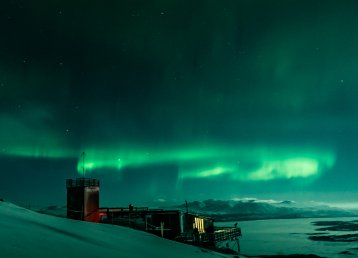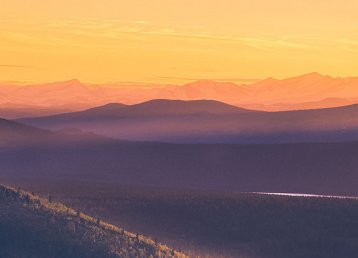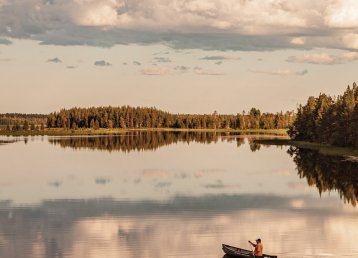In the late 1990s, The Wannadies released their compilation album Skellefteå, named after their home town. Where wet green grass meets dust and dirt / that’s where love no longer hurts, Pär Wiksten sings softly in My Home Town, the song that became a theme song for the coastal town. My Home Town is really about love at a distance. But I still imagine that The Wannadies describe Skellefteå as they saw the town back then: just strolling around streets filled with the dust of summer, in a town that seemed like it would never change. I am familiar with that feeling, too, of course. It is the teenage mantra of sleepy industrial towns: there is nothing to do here. Just pop music, ice hockey and factories. Even though we were jumping to rock music during street festivals, music that sounded larger than the places it was rooted in. It was music that was aching to go, and we wanted to leave with it.
Something has happened since then. This is a different decade, well, a different millennium to when The Wannadies released Skellefteå. Moving to a big city to live a creative life is no longer a matter of course, and it is no longer mandatory to write about this part of the country as something that was left behind and never changed.
To those of us who listen and read, this means we get to listen to other voices and get to know other realities, people and places through them – those that rarely find a place in popular culture. Kitok from Jokkmokk, for example, is usually described as “a voice for the countryside”. He sings a lot about his roots and his Sámi identity, a Jokkmokk and north as a metropolis in its own right, and he does it with pleasure. But there is ambivalence in Kitok, too, a pull between town and countryside that he describes best himself in Inland Empire: From the North from the town and the other way around / but see how far I’ve come. Another example is joik singer and artist Sara Ajnnak from Gargnäs who recaptures her Ume Sámi language and lets her own life be a starting point in her songs: the legacy of forced migration, land exploitation, being a Sámi woman.
The musicians from Gällivare
All around Swedish Lapland, other musicians and writers conquer their language and artistic expressions, with their feet firmly placed in the culture and geography that shaped them. As if there is an insight now that it is possible to be something different and tell stories about what is ours: as if you are plugged straight into the do-it-yourself attitude that runs through the northern countryside like an artery.
It might be in Gällivare they do it best. This is home to two people who have clearly placed Lapland as the axis of the world – centre and periphery at the same time – in their creations: poet David Väyrynen and musician Johan Airijoki. Both of them seem to have derived their language and expressions from the ore-rich bedrock.
David Väyrynen published his debut Marken (‘The Ground’) in 2017, a kind of literary catalogue of the sparse countryside in the north in both form and content that attracted a lot of attention. Not far from him, we find artist Johan Airijoki, who once described his songs as “stories from the ground floor”. He is a rock musician who sings about working shifts, vodka belts and silence, about forest clearing and snowmobile trails and marshland, allowing the larger philosophical questions in life – class, masculinity, the betrayal of the big society – to be glimpsed among words that are so straight to the point they sometimes leave me blushing.
Johan Airijoki
“Hold on, I’m just going to take a snus”, says Johan Airijoki when I call him to talk about what happens when you create music about a place like Gällivare and the people and nature there. It was only when Johan moved back after a few years studying in Umeå that he found his place, he says when the snus is firmly in place, and I cannot help but think of some lines from his After-ski Ikaros: I bought myself a leather vest and started using snus to be free / I moved home to Lapland and played covers at after-ski / Because I fly towards the sun and the guitar it sings with me.
– When I moved back home, it felt like a lot fell into place. I had an idea about what kind of music I could be doing and what expression it would have.
In Gällivare, there is a lot of rock and rockabilly, he tells me, and American car culture. There were other local things too, like the dialect and the typical jargon.
– It was an interesting mix. It was something I hadn’t heard before, and it meant the music worked well. It felt wonderful and raw, for real.
So far, Johan Airijoki has released three full-length albums under his own name, and a fourth is in progress. Those released so far revolve around what it means to be a person in his surroundings, among motor homes, inland petrol stations and moonshine makers. I have no reason to believe that the fourth, in production, will be any different, but I forget to ask him about it.
The stories are taken from his everyday life, everything happening around him and sometimes inside Johan himself. He brings the listener down into the mine, out into the marshland and pine forests, with eyes towards the mountains and the illuminated town streets. The surrounding nature is present in many of Johan Airijoki’s lyrics. I myself do not think of them as romanticising – but when I ask, he defends himself.
– I’m actually a romantic son of a gun. But I definitely don’t want to do some kind of postcard art. It has to be abrasive in some way. Too many up here, nature isn’t just a place where you have fun and relax; it’s a workplace too and a place where you get food and firewood.
Stories from the ground floor
The stories on En blyg viol (‘A Shy Violet’) (2018), Allting kommer att bli bra (‘Everything Will Be Fine’) (2017), and Vissa saker måste brännas (‘Some Things Must Be Burnt’) (2015) are both poetic and documentary. He is observant as a person, he says, attentive to moods and impressions.
– I’m quite good at creating meaning. I can create a story about things that people might think are small and trivial.
As in Meter och ton (‘Meter and Tone’) where a scruffy little fox with scabies, running among the songlines, comes to a standstill. An image that summarises most things that needed to be said right there.
– There isn’t much said in popular music about my context, in my generation. It’s not crowded. There’s a lot for me to interpret, he says.
What he is portraying is a place that is so different to live in compared to a big city. It could also be perceived as strange and exotic, especially since the place is so unexplored in terms of pop culture. But, Johan says, people are people.
– If you just find something that’s honest and interesting, you can relate to it, whether you live in Gällivare or Stockholm’s inner city.
It’s just that these stories haven’t been used that much; nothing has become worn.
– There are some pop and rock clichés that I try to translate into my own context, like Vodkabältet (‘The Vodka Belt’). It could have been an American rockabilly song about drinking whiskey, but I sing about our alcohol culture and drinking moonshine.
I'm trying to nuance the image of a man from the north, which is quite a limited image.
Musically, he seems to move seamlessly between extremes. On the one hand, rockabilly, rock and blues, on the other hand, you can sometimes hear indie and finely-tuned folk music. When
I ask him about it, Johan says there is a musical curiosity in him, that he is into several different kinds of music genres. He listens to everything, and some things might stay with him.
– The people I play with are also very interested in music. Some have studied jazz at college; the bassist plays in a country band, the guitarist has a death-metal band. It’s actually freedom when you live in Gällivare; you can do whatever you want, there’s no scene to belong to and nothing to measure yourself against. We pick and mix the things we like.
The lyrics and the music are created in unison, Johan says. He starts by playing and looks for a feeling, some kind of the core, in what he is playing. You have to find the kind of lyrics that feel right in your mouth, he continues, that you feel are honest, and that you can stand behind when you stand on stage.
– I try to whittle it down and make it as basic as I can – the lyrics should be as straight as possible. Rock music can’t be wishy-washy; it has to be straight-shooting, he says.
It is straight, sometimes rough. “Stories from the ground floor”. A critic who fails to listen carefully might call it excessive, possibly also stereotyped. But in places, it is also very delicate and fragile.
– I’m trying to nuance the image of a man from the north, which is quite a limited image. You’re supposed to be tough and take it, hunt, wear a flannel shirt and work. There’s nothing else. I’m quite a sensitive person, and I notice that people around me also have an emotional life. It’s almost forbidden in one way. You shouldn’t go poking into that kind of stuff. It’s rather fragile masculinity, and there’s something very vulnerable about it that I try to describe. As a man, you also want to live like a whole person.
Northern roots
While talking to Johan, I think of the pride he seems to feel. I want to describe his music as honest and open, a kind of upright decision to be the man you are, where you feel at home. It is not music that sounds larger than the place it is rooted in. Instead, it is music that is interesting and exciting because of its geographic and cultural origin – and of course, its creator’s entire person: the shy violet who stood up and flew towards the sun, in the company of his guitar.
– Yes, I feel great pride. I haven’t always. I feel proud that I don’t compromise on how I speak or how I express myself, that I’m proud of where I come from, that my roots are in the Torne river valley, and that I know my own history. I’m proud of that, he concludes.
Perhaps it is that pride that makes it different. A pride of northern roots, language and life, what is special about here that cannot be found anywhere else – what the ice-hockey fans at Skellefteå Kraft Arena have understood and express as they roar My Home Town with all their heart. The pride is undeniably there. From Kitok, who lets home be just what Paradise Jokkmokk is, to David Väyrynen, who transmits everyday life in Gällivare in a way that appeals to many. From mountain to coast via Sara Ajnnak, who raises her chin and looks straight into the camera, in the music video Reäjnnuo neäjdda.
Always proud. From The Ground to ice hockey. From rock to hip hop. From joik to Airijoki.


























